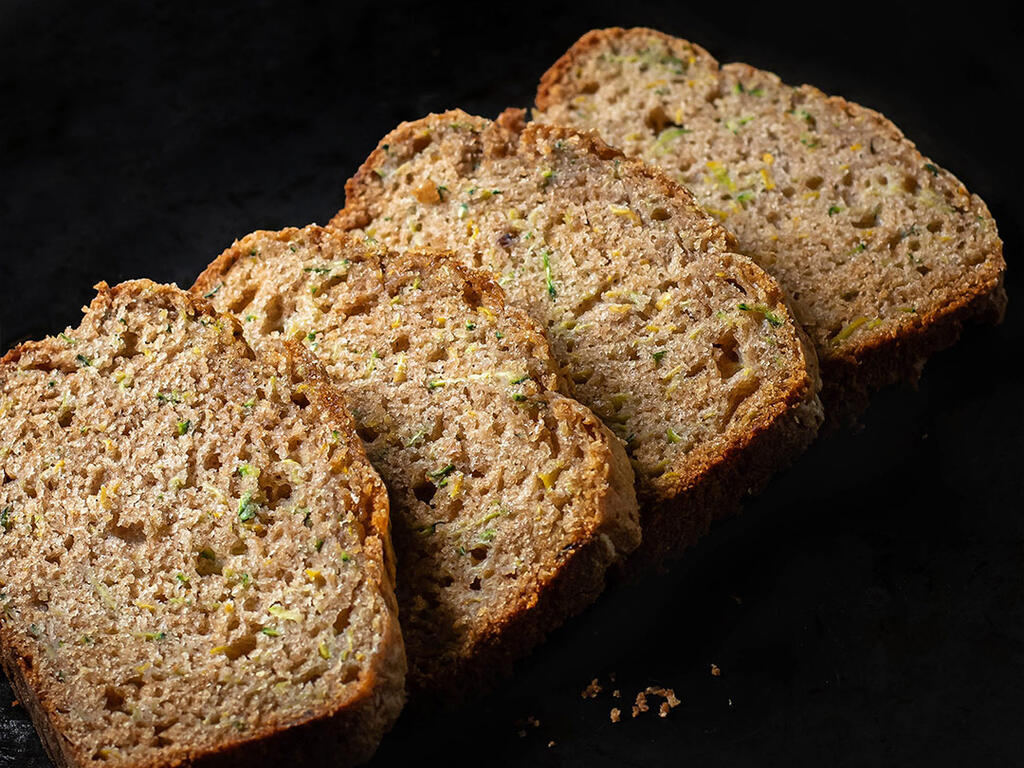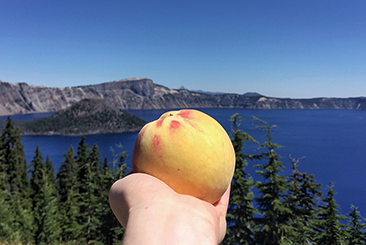Tartine's Zucchini and Orange Marmalade Tea Cake

RECIPE UPDATED 9/6/22
Elisabeth Prueitt's cookbook, Tartine, is usually my first stop when searching for baked goods. I found her Zucchini and Orange Marmalade Tea Cake a while back when some beautiful zucchini from The Garden Of needed a home. As is always the case with recipes in Tartine, this quick bread is spot on. The cookbook describes the zucchini flavor as "barely discernable" which is true but not an issue. The tea cake lasts for days, has a balanced flavor, and everything comes together in a relatively fast and unfussy process.
Zucchini's high water content can create a gummy situation so this post includes tips that will ensure your quick bread has a light and even texture throughout. A bonus is that my gently adapted version is 25% Grist & Toll whole grain spelt which adds nutty notes while still retaining the lovely crumb you see above. I didn't alter the recipe to accommodate the whole grains so if you want to use 100% all-purpose flour no changes are needed.
Publishing this post in October feels a little late, but it's going to be 80° this week and I still have SoCal zucchini in the fridge. Mother Nature has chosen to remain on summer break so I'm rolling with it.

Original vs. Adapted
Sugar
The recipe calls for sprinkling two tablespoons of granulated sugar across the top before baking. I only use one tablespoon and sometimes leave it off altogether depending on my mood. It's up to you how much sweet crunch you want on the top.
Nuts
The cookbook suggests 4 ounces (115 grams) of walnuts but I use 3 ounces (88 grams).
Flour
As mentioned above, 25% of the white flour was replaced with Grist & Toll whole grain spelt. Whole grain Sonora, Wit Wolkoring, or similar soft white wheats will also work. I've made this recipe with up to 40% spelt and it was very good though it probably needed a bit more moisture with that much whole grain.
Recipe Tips
Timing
Your main enemy with zucchini bread is the moisture content of the vegetables. Don't grate the zucchini until the oven is ready, flour is sifted, and oil mixture is prepped.
Batter Texture
The batter's consistency will be very thick. If your batter is watery or runny, you may have added the zucchini too early, grated too soon, or pulverized the zucchini during the grating step. Zucchini starts releasing liquid when the cell walls are broken and when it comes into contact with salt and sugar, hence all the tips on being prompt with that ingredient.
Baking BFF
At a minimum, use a scale to measure in ounces. I prefer to measure in grams whenever possible and generally avoid using measuring cups. The reason...
One of the many things I like about the Tartine cookbook is that it offers multiple units of measurement (ounces, cups, grams). Out of curiosity, I scooped and scraped a 1/2 cup of marmalade as is specified in the book and then weighed it. My scale showed 5 ounces which is one ounce more than the 4 ounces listed next to 1/2 cup. Variants like that can be significant when it comes to baked goods. Some people feel measuring is stifling but I like to think of it as empowering. Once I nail a recipe and have a repeatable process, then that opens up the opportunity to experiment since my base is solid. Different strokes.
More Measuring
You may end up with a slightly wet or gummy middle if the center of the bread comes up 5-10°F short. Smell and sight are important when it comes to baking but in the last 10 minutes there is little visual difference between 203 and 210 degrees. Measure the internal temperature of the tea cake in the center and on the edge. I use my Thermapen since it's fast, accurate, and has a long thin design that can act as a cake tester.
Room Temperature
I’ve mentioned this in a few recipes including Tartine’s Pumpkin Tea Cake and Violet Bakery’s Banana Bread - room temp ingredients are important. You're adding in vegetables that are high in moisture and you don't want the batter to work any harder than is necessary to cook through.
Step Away from the Whisk
Overmixing the batter encourages gluten development which can make the crumb tough or dense. I've included additional notes under "Instructions" to help ensure mixing is minimized.
Orange Marmalade Substitutes
Orange marmalade (as the original recipe calls for) is my preference but apricot preserves also work.

Farmers | Artisans
I make an effort to source my food from California artisans with a special focus on the Santa Monica Farmers Market. Below is a list of the folks who contributed to this dish.
- Grist & Toll / Whole Grain Spelt Flour
- Central Milling (Sonoma) / Organic All-purpose Beehive
- Schaner Farms and Omma's Garden (aka Kaliko Farms) / Eggs
- The Garden Of and Finley Farms / Zucchini
Tools
- Mixing Bowl with Silicone Bottom / My go-to bowl for hand-mixed batters.
- Thermapen / I use my Mk4 daily for sourdough, coffee, meat, quick breads (doubles nicely as a cake tester), and more. It's fast, nimble, and a snap to clean.
- OXO Scale / Measure all the things. I've been using this scale for many years and it has done a great job.
- Good Cook Loaf Pan
- Cooling Rack
- Rosle Coarse Grater (or Microplane - I've used both)
- All-clad Mesh Strainer Set (or single OXO here)
- Rosle Whisk
Ingredients
- 68 grams (2 1/2 ounces) Grist & Toll whole grain spelt
- 202 grams (7 ounces) Central Milling organic all-purpose beehive
- ½ teaspoon baking soda
- ½ teaspoon baking powder
- 1 teaspoon ground cinnamon
- 2 large eggs (about 50 grams each out of the shell)
- 145 grams (5 ounces or ½ cup + 2 tablespoons) almond oil or similar
- 150 grams (5 ¼ ounces) granulated sugar
- 115 grams (4 ounces) orange marmalade Note: If your marmalade has some large pieces, cut them into smaller bits.
- 88 grams (3 ounces) walnut halves
- 285 grams (10 ounces) grated zucchini - about 3 small/medium Important: Per the "Recipe Tips", don't grate this in advance.
- ½ teaspoon fine sea salt
- 1 tablespoon sugar for topping
Instructions
- Bring the ingredients up to room temperature per the "Recipe Tips". Leave the eggs and zucchini whole during this period.
- Over medium heat, toast the walnuts in a small skillet until fragrant. When cool enough to handle, break the walnut halves into smaller pieces (by hand works well) and then set aside.
- Once the ingredients are at the proper temperature, pre-heat the oven to 350°F and move the rack to the middle position.
- Oil a 9x5 pan, dust with flour and discard the excess, then line the bottom of the pan with a cut-to-fit piece of parchment paper. Set aside.
- In a slip-proof bowl, combine 150 grams sugar, 145 grams almond oil, eggs, and marmalade then whisk to combine.
- In a separate bowl, combine the flours, baking soda, baking powder, and cinnamon then whisk to combine. Sift the flour mixture, then dump any bran flakes back into the pile and whisk again to combine.
- Grate the zucchini. Note: Don't complete this step until your oven is ready.
- Add the sea salt and walnuts to the oil mixture, whisk, then add the zucchini immediately afterwards. Gently whisk to combine.
- Promptly add the flour in 3 additions, adding each successive addition when the flour is about 50-75% incorporated. Note: I find a whisk (when used gently) quickly brings together the first two additions. Towards the third addition, I switch to a spatula for a final fold and to poke around for pockets of dry flour.
- Stop as soon as everything is incorporated. Do not overmix the batter.
- Scrape the batter into the pan and smooth the top - it should be very thick.
- Sprinkle the top with one tablespoon of sugar then bake immediately - don’t let the batter sit.
- Set a timer for 40 minutes and another for 55 minutes.
- At 40 minutes, rotate the pan from front to back then continue baking.
- At 55 minutes, use a digital thermometer to measure the center of the bread - target is around 208°F. Note: For reference, the center of my bread at this point is 205°F and the thermometer isn't coming clean. I usually bake for another 5 minutes. The original recipe calls for 60-70 minutes so my oven clocks in around 60 minutes.
- When the center of the bread measures 208°, remove the pan from the oven and place on a wire rack. Gently run a paring knife around the edge to loosen any bits that might be stuck. Set a timer for 10 minutes. After 10 minutes, gently invert the pan, peel off the parchment, then place the bread sugar-side up on the wire rack. Let it cool completely before slicing.
Storage
Elisabeth Prueitt suggests wrapping the zucchini bread tightly and then placing it in the refrigerator for up to 5 days. I prefer to slice and freeze some of the bread and then leave the rest at room temperature in an airtight container for a day or two. Placing a paper towel under and on top of the bread helps absorb moisture.
Coming Up
- Subscribe at the bottom of this page for new posts.







